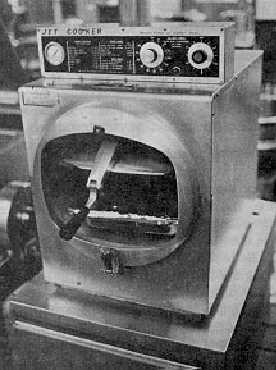| |
closing the valve, as necessary. The fault
normally is stoppage in the trap, strainer, or
drainpipe. To eliminate this condition, close the
steam valve, remove the steam-trap strainer
basket, and clean it by scraping out the solids and
washing the basket until the mesh or perforations
are open and clear. Clean the pipe connection in
the steamer compartment, reassemble the
strainer, and repeat the pressure cooking. If there
is still no drip, the steam trap is at fault, so report
this to the engineer officer via the chain of
command.
After each meal, the steamer should be brush-
scrubbed, washed clean with hot soapy water,
and rinsed with hot water (170°F) and allowed to
air dry.
HIGH-COMPRESSION STEAMER
The high-compression steamer (fig. 4-10) is a
modular unit that is used to defrost and cook food
by using high-velocity steam. When steam enters
the unit, it is piped to a jet box from which it is
jetted directly onto the frozen food at
approximately 200 miles per hour (mph). The
steam gains the high velocity by being forced
through a series of small perforations.
48.132
Figure 4-10.—High-compression steamer
Operation
Check the steam supply gauge; 15 psi is needed
for proper operation. Insert foods into the cooking
chamber; then place the frozen food directly under
the jet box; close and seal the door. Select the time
(from 5 to 60 minutes) for the food to be cooked.
Turn the selector switch to 60 minutes and then
back to the desired cooking time. The pilot light
indicates that cooking is in progress. Food is
defrosted and cooked auto-matically. The pressure
gauge rises to approxi-mately 5 psi and increases to
15 psi after 2 minutes, where it will stay until
cooking has been completed. The door must be kept
locked until the cooking cycle has been completed.
All steam will exhaust automatically and the buzzer
will sound when the cooking cycle has been
completed.
Care and Cleaning
The steamer should be cleaned at the end of each
day that it has been used. To clean the jet steamer,
remove the jet plate, pan supports, and door,
including the gasket around the door, and wash in
warm soapy water. Rinse well in warm water.
Scrub the interior of the cylinder with warm soapy
water and rinse well.
The door gasket must be kept clean at all times.
With normal closing and locking of the door
assembly, a steamtight seal should be made
between the door gasket and the door opening. This
seal cannot be maintained if particles of foreign
matter are allowed to accumulate upon either of the
contacting surfaces.
If leakage of steam occurs, the door assembly is
improperly adjusted and a readjustment must be
made to the adjustment screw.
VENTILATOR HOODS
Ventilator hoods, like people, come in a
variety of shapes, sizes, and appearances, and
vary in their effectiveness from barely acceptable
to highly efficient. The filter-type hoods fall
into the barely acceptable category, and the
filterless grease extractors–mostly known as
Gaylord ventilators–are the most efficient. Filter-
type hoods are the hardest to keep clean and
are gradually being re-placed as funds allow.
They generally have no built-in fire protection
system. If the filters are not replaced after cleaning,
a buildup of grease deposits in the exhaust duct
system could lead to a fire! Depending upon the
type of fumes exhausted and the amount of use, the
filter should be removed and washed in the
dishwasher or deep sink daily, or no less than once
4-13
|

